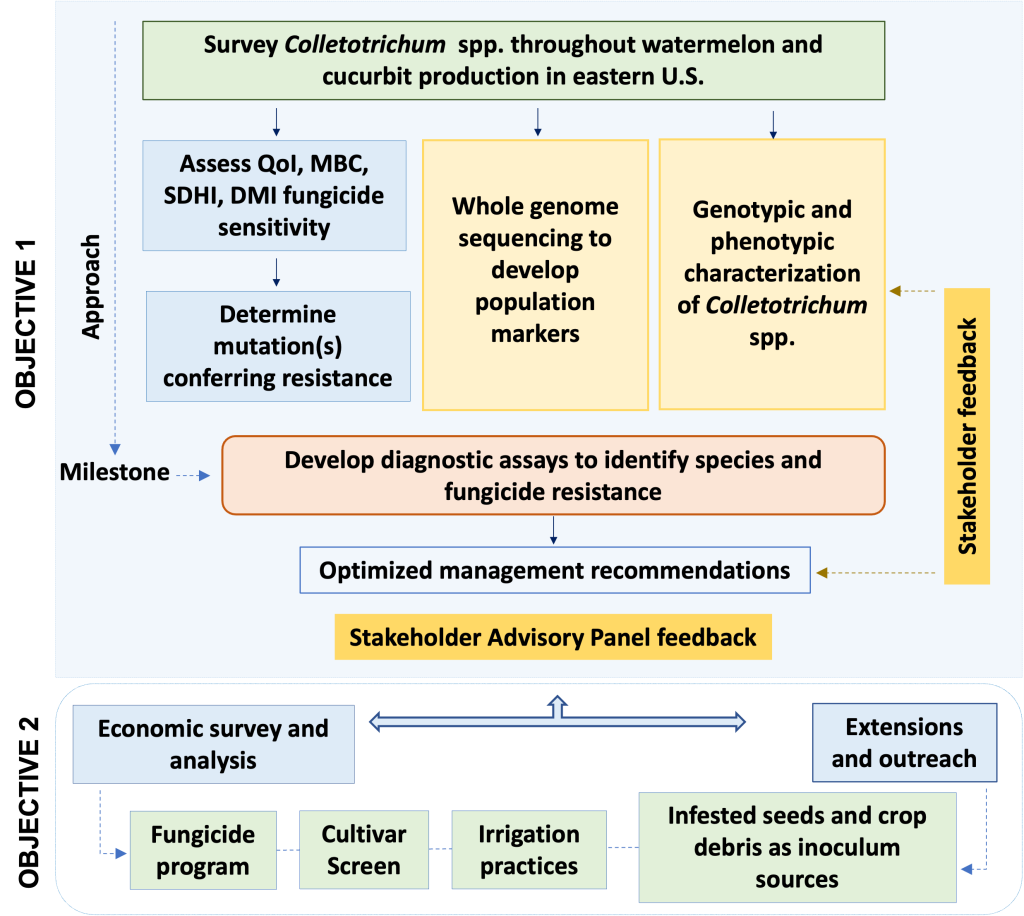Objectives & Approach

We will assess if debris and seeds play a role in anthracnose outbreaks in replicated field trials in watermelon and cucumber. We will further assess different crop debris management practices and seed treatments to reduce pathogen survival. We will conduct economic and stakeholder advisory panel assessments of regional trials each year that will enable us to determine the cost-benefit trade-off of recommended management strategies. Economic surveys through stakeholder engagement will be conducted to estimate the economic impact of cucurbit anthracnose on watermelon and cucumber growers. Standard extension platforms that will integrate feedback from the stakeholders will be used to disseminate outcomes of this project, which will ensure the highest likelihood of adoption.
OBJECTIVES:
Objective 1
Understand the pathogen population biology of emerging anthracnose epidemics of cucurbit crops in the eastern U.S. to improve management strategies. We will leverage genomics and population biology to identify the Colletotrichum species complex(es) involved in emerging watermelon and cucumber anthracnose epidemics in the eastern U.S.; determine the population genetic structure, host specificity, and fungicide resistance profile(s) of species involved; and develop PCR-based diagnostic tools for Colletotrichum species identification and detection of fungicide resistance against fungicide groups (QoI, MBC, DMI and SDHI) (45%).
Objective 2
Identify effective production and management practices to prevent or reduce cucurbit anthracnose. We will examine how different sources of inoculum (seed and crop debris), production practices (e.g., including drip vs. overhead irrigation), fungicide programs, host response in varietal selections and core PI collections of watermelon and cucumber lines contribute to cucurbit anthracnose outbreaks; and develop pre- and post-harvest management programs that are environmentally and economically viable (55%).
APPROACH:
Part 1:
Using standardized survey and isolation protocols, watermelon, cucumber, and other cucurbit crops (squash, cantaloupe) will be surveyed for anthracnose symptoms in seven eastern U.S. states representing more than 50% and 40% of the national watermelon and cucumber production, respectively (8-10 fields/state surveyed 2-3 times/season). Isolates collected will be used for the population biology and comparative genomics stuies. We will study pathogen species diversity using multilocus sequencing and pathogen population genetic structure and diversity using whole genome sequencing, single nucleotide polymorphism calling, and standard population genetic analyses. Host specificity and race-typing will be determined using a panel of cucurbit genotypes (watermelon, cucumber, squash, cantaloupe) in greenhouse bioassays. Resistance to QoI fungicides and development of molecular diagnostic assays for resistance and species identification will be determined using standard methods for plant-pathogenic fungi. Understanding the diversity and prevalence of Colletotrichum spp. as well as the QoI fungicide resistance profile in these regions will aid in development of practical methods, not only to detect Colletotrichum spp. but also to screen for QoI resistance within different populations.
Part 2:
We will examine how seed-borne inoculum and production practices, including drip vs. overhead irrigation, fungicide programs, host response in varietal selections and core PI collection of watermelon and cucumber lines, and seed treatments, contribute toColletotrichumspp. outbreaks of cucurbit anthracnose and develop pre- and post-harvest management programs that are environmentally and economically viable.
We will coordinate among seven eastern U.S. states (FL, GA, SC, NC, VA, DE and NY) and evaluate how production practices impact cucurbit anthracnose outbreaks: irrigation (type), selection of commercial cultivars (watermelon and cucumber) and fungicide programs. We will also coordinate with the CucCAP2 (SCRI PROPOSAL NO: 2020-51181-32139) group. This group has identified a panel of watermelon and cucumber breeding lines that are suitable for productivity and profitability; however, these lines have not been screened for cucurbit anthracnose. This project will provide an opportunity to screen these breeding lines along with other commercial cultivars, and the results will benefit both projects. The impact of cucurbit anthracnose on fruit yield, quality and marketability will be evaluated in replicated trial plots in FL, GA, SC, NC, VA, DE and NY.
Our project overview
